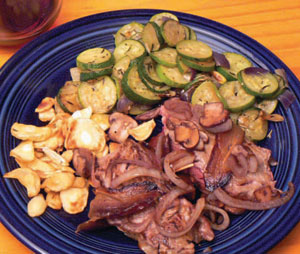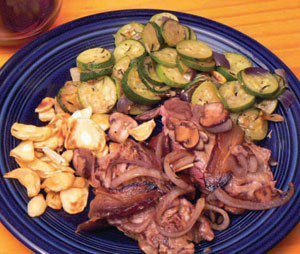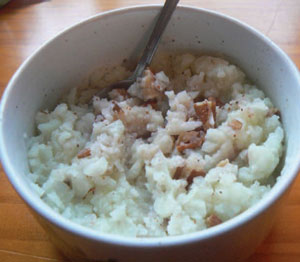Recipes: Issue 50

This month, I'll feature another simple, complete meal. Recently, my neighborhood meat department ran a special on beef tenderloin. I couldn't pass this up! The meal that I came up with using the tenderloin is featured this month.
Also, this month features a new post training meal, plus the breakfast of the month. Enjoy!
Bacon Wrapped Tenderloin
Time: 18 minutes
• 1 lb beef tenderloin
• 8 slices of bacon (no nitrites)
• 1 Tbsp olive oil, divided
• sea salt to taste
• 1 slice of red onion
• 1/2 cup sliced mushrooms
Place bacon onto a roasting pan and start baking in the oven at 350 degrees. Meanwhile, pre-heat a skillet to medium high and add 1 tsp olive oil. Cook the tenderloin in the hot skillet for one minute on each side. Plate and set aside.
Remove the bacon from the oven once it has become soft, but not crisp. Carefully wrap bacon around tenderloin, holding it in place with toothpicks.
Place the tenderloin on the roasting pan, lightly sprinkling the steak with sea salt. Return to the oven for around five minutes, checking frequently.
Meanwhile, add the mushrooms and sliced onion to a small skillet, along with 2 tsp of olive oil. Sauté for around 8 minutes, or until soft. Serve the wrapped tenderloin topped with the sauteed veggies.
Zone info: 4 servings at 4.5 protein blocks, 7.5 fat blocks. Carbs negligible.

Sauteed Zucchini
Time: 30 minutes
• 3 medium zucchini
• 1/2 cup red onion, chopped
• 1 Tbsp roasted hazelnut oil
• 3 cloves garlic
• 1 tsp thyme
• 1 tsp rosemary
• sea salt and pepper to taste
Chop the onions, then slice the zucchini. Toss them in a large skillet along with the oil. Cook covered on medium-low for about 25 minutes. Add thyme, rosemary and garlic about halfway through cooking time.
Zone info: 4 servings at 1.25 carb blocks, 2.25 fat blocks.
Roasted Parsnip Chips
Time: 45 minutes
• 2 cups sliced parsnips
• 1 tsp olive oil
Preheat your oven to 350 degrees. Wash, then thinly slice the parsnips. Toss the parsnips with the oil on a roasting pan or stone, then bake for 35-40 minutes. Check on them occasionally, tossing a couple of times when you do. When they are soft and slightly crisp, they are done.
Zone info: 4 servings at 1 carb block, .75 fat block.
Stampot
This is a Dutch favorite that I have tweaked to be a very good post-training meal. I have removed most of the fat, and upped the greens a bit to maximize recovery.
Time: 20 minutes
• 2 medium sweet potatoes or yams (I like to use one of each)
• 1 lb + of greens (use spinach, kale, endive, or a mix)
• 1 lb mild Italian chicken sausage (plain chicken breasts work well, too)
• 1/2 cup chopped onion
• 1/3 cup chopped bacon ends (nitrate free)
Chop the potatoes into 3/4" cubes. Place in a pot of boiling water, cook for about 12 minutes, or until soft. Be sure to reduce the heat so the potatoes don't boil over.
Meanwhile, in another pot, heat 1/2 cup of water. Add the chopped greens, and the sausage. Cover and simmer over low-medium for 10-15 minutes, until the greens are soft. The time will vary a bit depending on which greens you are using. Be sure to mix the meat and veggies from time to time while you cook them.
In a third small skillet, saute the bacon pieces and the onion. Cook until the onion is soft and the bacon has browned a bit, but not too much.
When the potatoes are done, drain and mash them with a potato masher. Drain the greens and then add them to the potatoes, along with the bacon and onion. Mix together well. Serve warm, or take it to the gym with you. Save the leftovers, and you will have a week's worth of recovery meals.
Zone info: 4 servings at 4 carb blocks, 4 protein blocks, 4.5 fat blocks.
Cauliflower Porridge
Here is a way to approximate porridge using cauliflower. From this basic template, you can create many different variants to suit your tastes or dietary needs.
Time: 10-15 minutes
• 1/2 large head of cauliflower
• 1/2 cup water
• 2 tsp coconut oil
• 1/8 tsp vanilla extract
• Pinch of nutmeg
• 1/4 cup chopped walnuts
• sea salt (optional)
Chop half of a large head of cauliflower into florets, then place in a pressure cooker with 1/2 cup of water. Bring up to pressure, then cook for about 2 1/2 minutes. Cool and depressurize. If you don't have a pressure cooker, steam or boil the cauliflower until soft. A time saving tip is to simply cook extra cauliflower the night before, then you will have it ready to make into porridge in the morning.
Put half of the cooked cauliflower into a blender along with the cooking water. Blend until smooth, adding a bit of water if needed. Pour the blended cauliflower into a saucepan, add the coconut oil, and heat over medium. Meanwhile, use a food chopper to roughly chop the remaining cauliflower. Add it to the saucepan, along with the vanilla extract and nutmeg. Chop the walnuts, then add them to the mix. Serve the porridge once it has become hot.
Variations:
1) Those who aren't strictly Paleo might substitute organic butter for the coconut oil.
2) Add one small chopped orange or tangerine to the porridge.
3) Add 1/2 tsp of real maple syrup for a slightly sweeter taste. Combining variations 2 & 3 is another option.
Zone info: 2 servings at .75 carb block, 9.5 fat blocks (basic recipe).

Also, this month features a new post training meal, plus the breakfast of the month. Enjoy!
Bacon Wrapped Tenderloin
Time: 18 minutes
• 1 lb beef tenderloin
• 8 slices of bacon (no nitrites)
• 1 Tbsp olive oil, divided
• sea salt to taste
• 1 slice of red onion
• 1/2 cup sliced mushrooms
Place bacon onto a roasting pan and start baking in the oven at 350 degrees. Meanwhile, pre-heat a skillet to medium high and add 1 tsp olive oil. Cook the tenderloin in the hot skillet for one minute on each side. Plate and set aside.
Remove the bacon from the oven once it has become soft, but not crisp. Carefully wrap bacon around tenderloin, holding it in place with toothpicks.
Place the tenderloin on the roasting pan, lightly sprinkling the steak with sea salt. Return to the oven for around five minutes, checking frequently.
Meanwhile, add the mushrooms and sliced onion to a small skillet, along with 2 tsp of olive oil. Sauté for around 8 minutes, or until soft. Serve the wrapped tenderloin topped with the sauteed veggies.
Zone info: 4 servings at 4.5 protein blocks, 7.5 fat blocks. Carbs negligible.

Sauteed Zucchini
Time: 30 minutes
• 3 medium zucchini
• 1/2 cup red onion, chopped
• 1 Tbsp roasted hazelnut oil
• 3 cloves garlic
• 1 tsp thyme
• 1 tsp rosemary
• sea salt and pepper to taste
Chop the onions, then slice the zucchini. Toss them in a large skillet along with the oil. Cook covered on medium-low for about 25 minutes. Add thyme, rosemary and garlic about halfway through cooking time.
Zone info: 4 servings at 1.25 carb blocks, 2.25 fat blocks.
Roasted Parsnip Chips
Time: 45 minutes
• 2 cups sliced parsnips
• 1 tsp olive oil
Preheat your oven to 350 degrees. Wash, then thinly slice the parsnips. Toss the parsnips with the oil on a roasting pan or stone, then bake for 35-40 minutes. Check on them occasionally, tossing a couple of times when you do. When they are soft and slightly crisp, they are done.
Zone info: 4 servings at 1 carb block, .75 fat block.
Stampot
This is a Dutch favorite that I have tweaked to be a very good post-training meal. I have removed most of the fat, and upped the greens a bit to maximize recovery.
Time: 20 minutes
• 2 medium sweet potatoes or yams (I like to use one of each)
• 1 lb + of greens (use spinach, kale, endive, or a mix)
• 1 lb mild Italian chicken sausage (plain chicken breasts work well, too)
• 1/2 cup chopped onion
• 1/3 cup chopped bacon ends (nitrate free)
Chop the potatoes into 3/4" cubes. Place in a pot of boiling water, cook for about 12 minutes, or until soft. Be sure to reduce the heat so the potatoes don't boil over.
Meanwhile, in another pot, heat 1/2 cup of water. Add the chopped greens, and the sausage. Cover and simmer over low-medium for 10-15 minutes, until the greens are soft. The time will vary a bit depending on which greens you are using. Be sure to mix the meat and veggies from time to time while you cook them.
In a third small skillet, saute the bacon pieces and the onion. Cook until the onion is soft and the bacon has browned a bit, but not too much.
When the potatoes are done, drain and mash them with a potato masher. Drain the greens and then add them to the potatoes, along with the bacon and onion. Mix together well. Serve warm, or take it to the gym with you. Save the leftovers, and you will have a week's worth of recovery meals.
Zone info: 4 servings at 4 carb blocks, 4 protein blocks, 4.5 fat blocks.
Cauliflower Porridge
Here is a way to approximate porridge using cauliflower. From this basic template, you can create many different variants to suit your tastes or dietary needs.
Time: 10-15 minutes
• 1/2 large head of cauliflower
• 1/2 cup water
• 2 tsp coconut oil
• 1/8 tsp vanilla extract
• Pinch of nutmeg
• 1/4 cup chopped walnuts
• sea salt (optional)
Chop half of a large head of cauliflower into florets, then place in a pressure cooker with 1/2 cup of water. Bring up to pressure, then cook for about 2 1/2 minutes. Cool and depressurize. If you don't have a pressure cooker, steam or boil the cauliflower until soft. A time saving tip is to simply cook extra cauliflower the night before, then you will have it ready to make into porridge in the morning.
Put half of the cooked cauliflower into a blender along with the cooking water. Blend until smooth, adding a bit of water if needed. Pour the blended cauliflower into a saucepan, add the coconut oil, and heat over medium. Meanwhile, use a food chopper to roughly chop the remaining cauliflower. Add it to the saucepan, along with the vanilla extract and nutmeg. Chop the walnuts, then add them to the mix. Serve the porridge once it has become hot.
Variations:
1) Those who aren't strictly Paleo might substitute organic butter for the coconut oil.
2) Add one small chopped orange or tangerine to the porridge.
3) Add 1/2 tsp of real maple syrup for a slightly sweeter taste. Combining variations 2 & 3 is another option.
Zone info: 2 servings at .75 carb block, 9.5 fat blocks (basic recipe).

|
Scott Hagnas is owner of CrossFit Portland. He is certified as a CrossFit level 2 trainer and Circular Strength Training (clubbell) instructor. He has been riding BMX flatland for 26 years and counting and has filmed/produced/edited several series of BMX videos, plus several training videos. He formerly competed in bicycle trials, placing second in amateur in the World Championships in 1990. Cooking is one of his favorite pastimes. |
Search Articles
Article Categories
Sort by Author
Sort by Issue & Date
Article Categories
Sort by Author
Sort by Issue & Date

